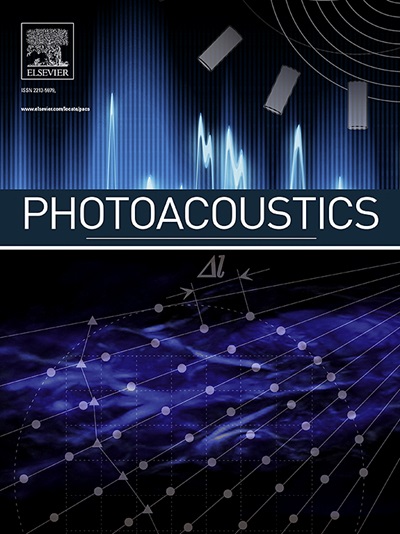Reconstructing multiple initial pressure and speed of sound distributions simultaneously in photoacoustic tomography
IF 7.1
1区 医学
Q1 ENGINEERING, BIOMEDICAL
引用次数: 0
Abstract
Image reconstruction in photoacoustic tomography relies on an accurate knowledge of the speed of sound in the target. However, the speed of sound distribution is not generally known, which may result in artefacts in the reconstructed distribution of initial pressure. Therefore, reconstructing the speed of sound simultaneously with the initial pressure would be valuable for accurate imaging in photoacoustic tomography. Furthermore, the speed of sound distribution could provide additional valuable information about the imaged target. In this work, simultaneous reconstruction of initial pressure and speed of sound in photoacoustic tomography is studied. This inverse problem is known to be highly ill-posed. To overcome this, we study an approach where the ill-posedness is alleviated by utilising multiple photoacoustic data sets that are generated by different initial pressure distributions within the same imaged target. Then, these initial pressure distributions are reconstructed simultaneously with the speed of sound distribution. A methodology for solving this minimisation problem is formulated using a gradient-based iterative approach equipped with bound constraints and a multigrid approach. The methodology was evaluated with numerical simulations. Different approaches for generating multiple initial pressure distributions and their effect on the solution of the image reconstruction problem were studied. The results show that initial pressure and speed of sound can be simultaneously reconstructed from photoacoustic data. Furthermore, utilising multiple initial pressure distributions improves the reconstructions such that the locations of initial pressure and speed of sound inhomogeneities can be better distinguished and image artifacts are reduced.
光声层析成像中多重初始声压和声速分布的同时重建
光声层析成像中的图像重建依赖于对目标声速的准确了解。然而,由于声速分布的一般不知道,这可能会导致重建的初始压力分布出现伪影。因此,同时重建声速和初始压力对于光声断层成像的精确成像是有价值的。此外,声速分布可以提供关于成像目标的额外有价值的信息。本文研究了光声层析成像中声速和初始压力的同时重建。这个逆问题是高度不适定的。为了克服这一点,我们研究了一种方法,该方法通过利用由同一成像目标内不同初始压力分布产生的多个光声数据集来减轻不适。然后,将这些初始压力分布与声速分布同步重构。解决这个最小化问题的方法是使用一个基于梯度的迭代方法,配备了绑定约束和多网格方法。通过数值模拟对该方法进行了评价。研究了生成多个初始压力分布的不同方法及其对图像重建问题求解的影响。结果表明,光声数据可以同时重建声压和声速。此外,利用多个初始压力分布改进了重建,从而可以更好地区分声不均匀的初始压力和速度的位置,并减少图像伪影。
本文章由计算机程序翻译,如有差异,请以英文原文为准。
求助全文
约1分钟内获得全文
求助全文
来源期刊

Photoacoustics
Physics and Astronomy-Atomic and Molecular Physics, and Optics
CiteScore
11.40
自引率
16.50%
发文量
96
审稿时长
53 days
期刊介绍:
The open access Photoacoustics journal (PACS) aims to publish original research and review contributions in the field of photoacoustics-optoacoustics-thermoacoustics. This field utilizes acoustical and ultrasonic phenomena excited by electromagnetic radiation for the detection, visualization, and characterization of various materials and biological tissues, including living organisms.
Recent advancements in laser technologies, ultrasound detection approaches, inverse theory, and fast reconstruction algorithms have greatly supported the rapid progress in this field. The unique contrast provided by molecular absorption in photoacoustic-optoacoustic-thermoacoustic methods has allowed for addressing unmet biological and medical needs such as pre-clinical research, clinical imaging of vasculature, tissue and disease physiology, drug efficacy, surgery guidance, and therapy monitoring.
Applications of this field encompass a wide range of medical imaging and sensing applications, including cancer, vascular diseases, brain neurophysiology, ophthalmology, and diabetes. Moreover, photoacoustics-optoacoustics-thermoacoustics is a multidisciplinary field, with contributions from chemistry and nanotechnology, where novel materials such as biodegradable nanoparticles, organic dyes, targeted agents, theranostic probes, and genetically expressed markers are being actively developed.
These advanced materials have significantly improved the signal-to-noise ratio and tissue contrast in photoacoustic methods.
 求助内容:
求助内容: 应助结果提醒方式:
应助结果提醒方式:


